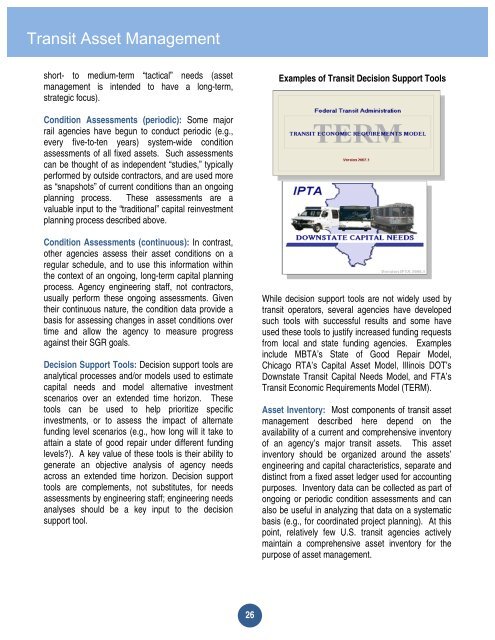Beginning the Dialogue - Report on SGR - Federal Transit ...
Beginning the Dialogue - Report on SGR - Federal Transit ...
Beginning the Dialogue - Report on SGR - Federal Transit ...
Create successful ePaper yourself
Turn your PDF publications into a flip-book with our unique Google optimized e-Paper software.
<strong>Transit</strong> Asset Management<br />
short- to medium-term “tactical” needs (asset<br />
management is intended to have a l<strong>on</strong>g-term,<br />
strategic focus).<br />
C<strong>on</strong>diti<strong>on</strong> Assessments (periodic): Some major<br />
rail agencies have begun to c<strong>on</strong>duct periodic (e.g.,<br />
every five-to-ten years) system-wide c<strong>on</strong>diti<strong>on</strong><br />
assessments of all fixed assets. Such assessments<br />
can be thought of as independent “studies,” typically<br />
performed by outside c<strong>on</strong>tractors, and are used more<br />
as “snapshots” of current c<strong>on</strong>diti<strong>on</strong>s than an <strong>on</strong>going<br />
planning process. These assessments are a<br />
valuable input to <str<strong>on</strong>g>the</str<strong>on</strong>g> “traditi<strong>on</strong>al” capital reinvestment<br />
planning process described above.<br />
C<strong>on</strong>diti<strong>on</strong> Assessments (c<strong>on</strong>tinuous): In c<strong>on</strong>trast,<br />
o<str<strong>on</strong>g>the</str<strong>on</strong>g>r agencies assess <str<strong>on</strong>g>the</str<strong>on</strong>g>ir asset c<strong>on</strong>diti<strong>on</strong>s <strong>on</strong> a<br />
regular schedule, and to use this informati<strong>on</strong> within<br />
<str<strong>on</strong>g>the</str<strong>on</strong>g> c<strong>on</strong>text of an <strong>on</strong>going, l<strong>on</strong>g-term capital planning<br />
process. Agency engineering staff, not c<strong>on</strong>tractors,<br />
usually perform <str<strong>on</strong>g>the</str<strong>on</strong>g>se <strong>on</strong>going assessments. Given<br />
<str<strong>on</strong>g>the</str<strong>on</strong>g>ir c<strong>on</strong>tinuous nature, <str<strong>on</strong>g>the</str<strong>on</strong>g> c<strong>on</strong>diti<strong>on</strong> data provide a<br />
basis for assessing changes in asset c<strong>on</strong>diti<strong>on</strong>s over<br />
time and allow <str<strong>on</strong>g>the</str<strong>on</strong>g> agency to measure progress<br />
against <str<strong>on</strong>g>the</str<strong>on</strong>g>ir <strong>SGR</strong> goals.<br />
Decisi<strong>on</strong> Support Tools: Decisi<strong>on</strong> support tools are<br />
analytical processes and/or models used to estimate<br />
capital needs and model alternative investment<br />
scenarios over an extended time horiz<strong>on</strong>. These<br />
tools can be used to help prioritize specific<br />
investments, or to assess <str<strong>on</strong>g>the</str<strong>on</strong>g> impact of alternate<br />
funding level scenarios (e.g., how l<strong>on</strong>g will it take to<br />
attain a state of good repair under different funding<br />
levels?). A key value of <str<strong>on</strong>g>the</str<strong>on</strong>g>se tools is <str<strong>on</strong>g>the</str<strong>on</strong>g>ir ability to<br />
generate an objective analysis of agency needs<br />
across an extended time horiz<strong>on</strong>. Decisi<strong>on</strong> support<br />
tools are complements, not substitutes, for needs<br />
assessments by engineering staff; engineering needs<br />
analyses should be a key input to <str<strong>on</strong>g>the</str<strong>on</strong>g> decisi<strong>on</strong><br />
support tool.<br />
26<br />
Examples of <strong>Transit</strong> Decisi<strong>on</strong> Support Tools<br />
While decisi<strong>on</strong> support tools are not widely used by<br />
transit operators, several agencies have developed<br />
such tools with successful results and some have<br />
used <str<strong>on</strong>g>the</str<strong>on</strong>g>se tools to justify increased funding requests<br />
from local and state funding agencies. Examples<br />
include MBTA’s State of Good Repair Model,<br />
Chicago RTA’s Capital Asset Model, Illinois DOT’s<br />
Downstate <strong>Transit</strong> Capital Needs Model, and FTA’s<br />
<strong>Transit</strong> Ec<strong>on</strong>omic Requirements Model (TERM).<br />
Asset Inventory: Most comp<strong>on</strong>ents of transit asset<br />
management described here depend <strong>on</strong> <str<strong>on</strong>g>the</str<strong>on</strong>g><br />
availability of a current and comprehensive inventory<br />
of an agency’s major transit assets. This asset<br />
inventory should be organized around <str<strong>on</strong>g>the</str<strong>on</strong>g> assets’<br />
engineering and capital characteristics, separate and<br />
distinct from a fixed asset ledger used for accounting<br />
purposes. Inventory data can be collected as part of<br />
<strong>on</strong>going or periodic c<strong>on</strong>diti<strong>on</strong> assessments and can<br />
also be useful in analyzing that data <strong>on</strong> a systematic<br />
basis (e.g., for coordinated project planning). At this<br />
point, relatively few U.S. transit agencies actively<br />
maintain a comprehensive asset inventory for <str<strong>on</strong>g>the</str<strong>on</strong>g><br />
purpose of asset management.

















